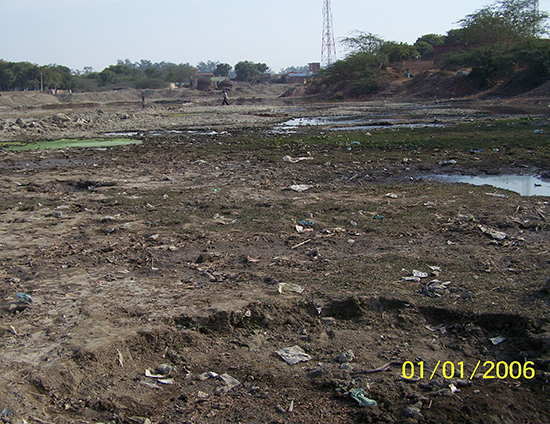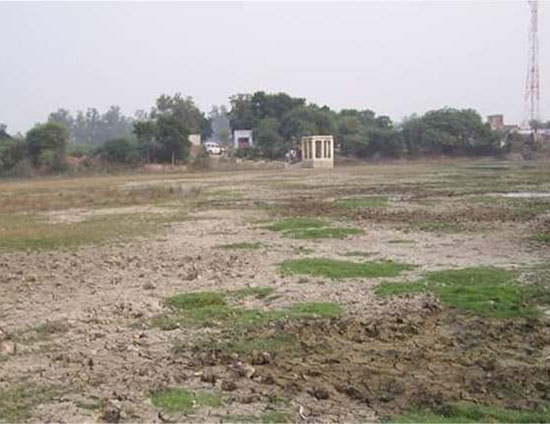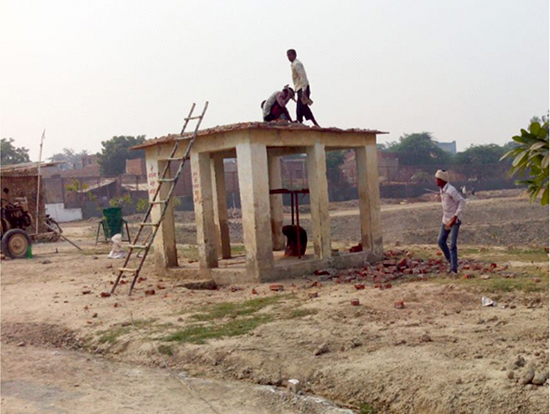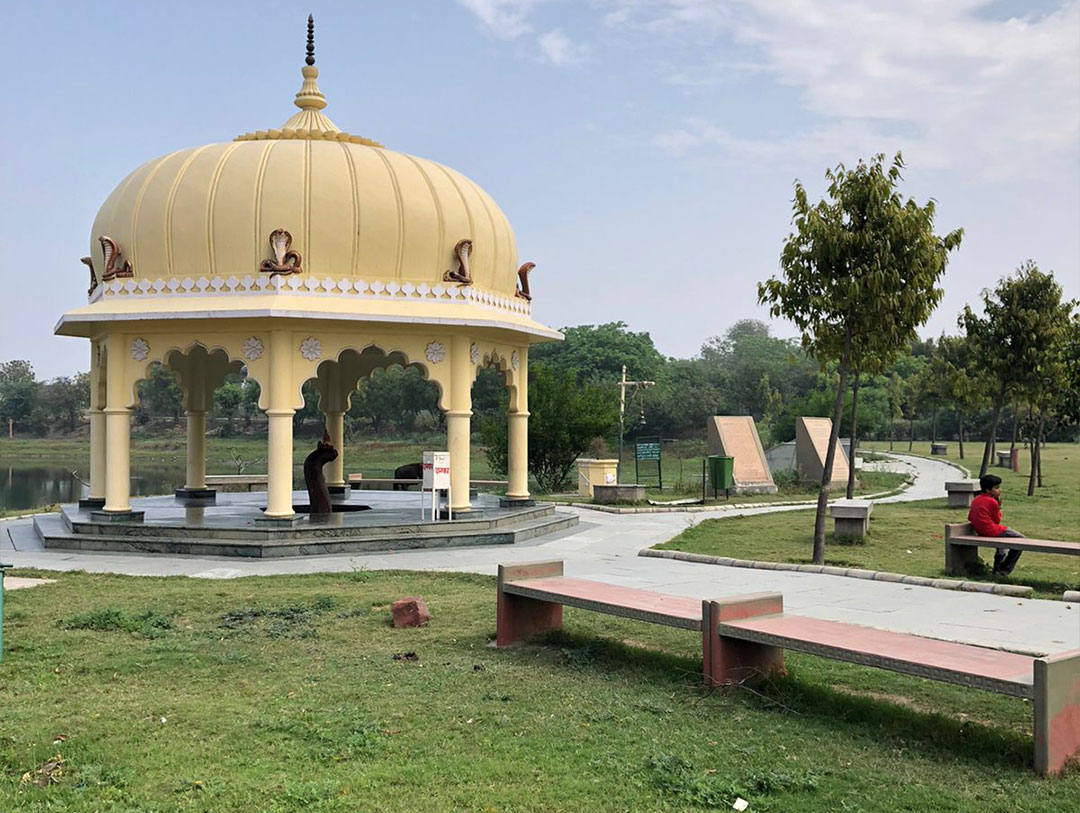
It was here that Lord Krishna killed the demon Aghasur, who had assumed the form of a python. Aghasur was the younger brother of demon Putna and Bakasur, who were killed by Krishna previously. Once, while wandering in Ajay Van, Aghasur saw Krishna and Sridama along with other cowherd friends and thought of avenging the murder of his siblings. The python laid down here with a gigantic body running for miles, intending to swallow Krishna and his friends. Innocent cowherd boys perceived this as some new adventurous spot of Vrindavan and out of curiosity entered his mouth and died instantly. Lord Krishna too immediately entered the mouth of the fierce demon in order to save his friends.
Aghasur wanted to chew Lord Krishna. But at the same time Krishna started expanding himself which choked the throat of the demon with eyes popping out in pain.Aghasur started wriggling and died within minutes. Out of extreme joy, Brajwasis acclaimed Lord Krishna by shouting “Nandlal ki Jai” (victory to the son of Nand). It was so loud that their voice echoed back after touching Vaikunth, hence creating a huge kund here. Since then the Kund is known as ‘Jai Kund’ and the village is known as ‘Jait’.
The popular lore is that when child Krishna chastised Kaliya Naag for polluting Yamuna and dance on his hood, He was about to kill him. At this point ‘Naagpatniyan’ (wives of serpent) pleaded Krishna for forgiveness for their husband. Krishna agreed on the condition that Kaliya Naag will instantly leave Yamuna and will never come back to Vrindavan. He also warns Kaliya that if he ever looked back, he will turn into a stone.
Kaliya Naag immediately came out of Yamuna and speedily ran away from Vrindavan. It was here (Jait), out of anxiety, he looked back towards Vrindavan and instantly became stone. According to Brajwasis this stone snake is the same and has existed here for the last 5500 years.
It is a prime location on the Agra-Delhi National Highway-44. The builder mafia had an eagle eye on this extremely valuable property. Half of the land was encroached upon by the villagers who had erected their dwellings on it and the remaining land was a garbage dump yard and open toilet for the villagers covered with filth, dirt and unbearable foul smell. There was no sign of Jai Kund except for some low line area. Amidst such hell stood a small structure in the name of Naag temple. It had six brick pillars and a roof of casually kept stone slabs. Underneath was a stone carved of a multi hood snake known as ‘Kaliya Naag’.
Decades ago the annual Naag Panchami mela was also used to be held here, which vanished with the passage of time.



In 2006, on the written request of the villagers and Gram Sabha, we surveyed this site. Our survey team finds out the history of this village and site in scriptures, folklore and revenue records. So, we decided to develop it. The de-silting of this Kund was done with the generous financial support of its Founder Chairman Mr. Kamal Morarka (CMD of Gannon Dun Kerley Group Mumbai). The desilting of a waterbody is a long drown cumbersome process. We needed several earthmovers, tractor trolleys and laborers.
It took years to complete because the time frame is confined between November to June every year. These being dry months, desilting can be done smoothly. Rest of the year due to monsoon the desilted portion gets filled with water and surroundings get marshy. It is impossible for earthmovers to operate in such slippery land. So the different levels of desilting are accomplished in a minimum of three years. We spread the silt and soil around that Kund for the landscape purpose and planted fruit bearing plants on that. We dug up to the point the aquifers opened up. IIT Roorkee has done a thesis on our Kund restoration projects. It has been established that due to The Braj Foundation’s effort water table have gone up in every village wherever we have undertaken this exercise. This fact has also been endorsed by several villagers in TV interviews.
Post de-silting, Revenue Department, UP Govt. was approached to remove the illegal encroachments from its catchment area, so that the glorious state of the site can be revived. Afterwards barbed wire fencing was installed all around the periphery of the Kund to protect it from any encroachments in future.
The Foundation’s architects prepared the design to develop the site in an aesthetic way and divided the project into several components. These included landscaping of the Ajay Van, construction of Kaliya Mardan temple, beautifully planned pathways, tourist facilities like toilets, drinking water points and benches etc. signage, and stone plaques glorifying the history of this historic site, an open air theater for performing rassleela or Bhagwat Kathas, concrete and stone dioramas of Aghasur killing leela & rejoicing Brajwasis, a camp office to keep our gardening equipments, deity paraphernalia and for our watchman to live.
Last but the most important component was the boundary wall. All this was accomplished in a few years period as and when we kept getting sponsors for each component. Today, it stands as one of the most attractive pilgrimage destinations and recreational park for the village community.
A drainage system was constructed to divert the drains flowing into the Kund from the MPLAD funds sanctioned by Mr. H. K. Dua, Rajya Sabha MP. A channel was also constructed from the same funds, to divert the overflow of the Kund.
Jamnalal Bajaj Foundation (Mumbai) donated Rs. 50 Lakhs to support the renovation of this project. On our proposal, the Ministry of Tourism, GoI under its PRASAD scheme sanctioned Rs 275 Lakhs for the development of major components of this project, executed by the Department of Tourism, UP; since we do not accept government grants.



At the one end of Jai Kund, where the kaliya Naag deity has existed for centuries we decided to erect an octagonal temple in a Rajasthani chhatri (canopy) shaped style, with eight snakes sitting on each pillar. Inside the temple ceiling there are eight big frescos painted to depict ‘killing of Kaliya’ pastimes of Child Krishna. The floor is made of green granite to match with the surrounding greenery. The original deity of Kaliya Naag exists where it was.
The construction of this temple was aided by Mr. Rakesh Khanna, MD of Brass Ex India, Moradabad. As mentioned earlier besides the local Brajwasis pilgrims from far off places daily come in large numbers to visit this holy place.Besides restoring, developing and maintaining the Ajay Van complex, The Braj Foundation also revived a two day grand Naag Panchmi Mela at the Kaliya Naag temple, which used to be held here a few decades ago. Now this annual mela attracts more than 25000 people from surrounding villages.
The site is maintained by the joint effort of the Village community and The Braj Foundation. This means a monthly expenditure of around forty thousand rupees on The Braj Foundation, to pay electricity bills, salaries of gardeners, watchmen, pujari, horticulture and civil works etc with no income at all.
















